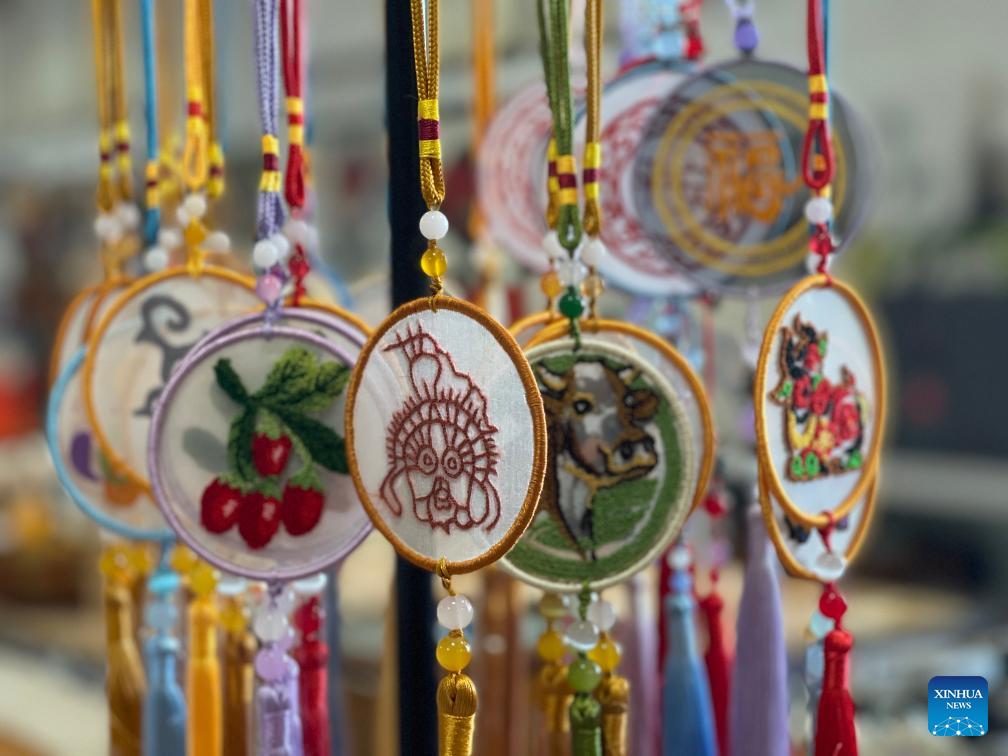Traditional skills revitalized by livestreaming in remote towns
 0 Comment(s)
0 Comment(s) Print
Print E-mail Xinhua, November 22, 2023
E-mail Xinhua, November 22, 2023

This photo taken on Nov. 3, 2023 shows driving cab pendants bearing embroidery in different patterns at Qiao Yaru's workshop in Haiyuan County of Zhongwei City, northwest China's Ningxia Hui Autonomous Region. [Photo/Xinhua]
In the absence of a professional setting and fill light, a mobile phone and a mobile phone holder are all that Du Zhanping can count on for his livestreaming efforts.
Yet it was through this primitive set-up that the 46-year-old man in Xuanhe Township of northwest China's Ningxia Hui Autonomous Region managed to get a traditional felt making skill known to viewers across the country.
In the husbandry region of Ningxia more than 1,000 kilometers from China's capital, people used to make felt with wool by pressing, rubbing and rolling, creating items which once featured in the dowry of almost every woman.
Du is an inheritor of this traditional felt making skill, which is on the regional intangible cultural heritage list. Each generation of his family has made a living based on this skill. With the improvement of people's living standards over time, however, felt has been used less and less, resulting in the industry waning.
In 2021, after taking part in entrepreneurship training, Du opened an account on short video platform Kuaishou to try livestreaming of the process of traditional felt making.
Starting from scratch, he learned by himself how to film and then edit video, and is now a proud owner of an account with 150,000 followers. One video alone has attracted more than 18 million views.
"Every morning I do livestreaming for more than two hours, chatting with the viewers and answering their questions," Du said while using a bow-shaped tool to make his wool fluffy. Normally he receives three to five orders during a single livestreaming session.
"Thanks to social media, my number of felt orders has now doubled, with those from online platforms accounting for about 70 percent of the total," he continued. "Had there not been online platforms, I might have already given up, with the traditional skill lost."
Du Zhanping is not alone. In recent years, livestreaming has helped breathe vitality into intangible cultural heritages.
In Haiyuan County of Zhongwei City, also located in Ningxia, 42-year-old Qiao Yaru is an inheritor of traditional embroidery, another regional intangible cultural heritage. She just finished livestreaming in her studio, featuring dazzling handbags, clocks, lamps, fans and pendants embroidered with different patterns, which sold well among youngsters.
"After watching my livestreaming, many young people including those from Generation Z become interested in our traditional skills," she told Xinhua.
"From this remote landlocked region, livestreaming is helping to promote our artwork to farther areas," she added.
It has also increased the income of local people, as more of them are getting involved in the industry. After training, Qiao's fellow villagers have the potential to get their embroidery pieces sold through online platforms, raking in as much as 2,000-plus yuan (about 278.6 U.S. dollars) a month.
"By bringing intangible cultural heritages into livestreaming studios, we can not only introduce them to more people while preserving traditional techniques, but also expand their markets to boost both the confidence and income of inheritors," said Wang Xiaoqin, vice head of the cultural center of Zhongwei.
"In this way, we can revitalize our traditional treasure," Wang added.





